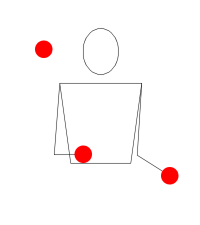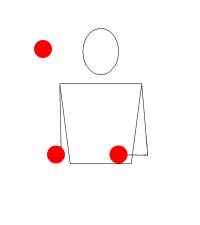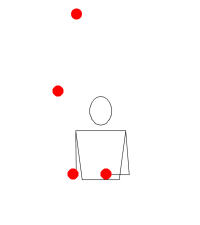| 16161 | |
|---|---|
 3 ball inferior pseudoshower | |
|
Capacity |
3 |
|
Period |
5 |
|
Full period |
15 |
|
Orbits |
1 |
|
Composition |
Prime |
|
(Excited state) | |
|
13131 | |
| 61616 | |
|---|---|
 4 ball superior pseudoshower | |
|
Capacity |
4 |
|
Period |
5 |
|
Full period |
20 |
|
Orbits |
2 |
|
Composition |
Prime |
|
(Excited state) | |
|
41414 | |
A pseudoshower is a pattern where one hand throws high and the other hand catches the high throws and passes them into the throwing hand, like in a shower, but the high throws don't cross, and the pattern is symmetrical.
The siteswap notation for an asynch pseudoshower has even-number throws alternating with 1s and an odd period, instead of having odd-number throws alternating with 1s and an even period like a shower. One hand keeps making high non-crossing throws while the other hand passes objects to it, until the throwing hand has thrown all but one object, and then the pattern changes direction so that the other hand throws high.
Any given even number can be used in a siteswap pattern to make two different asynch pseudoshowers: in a superior pseudoshower, the siteswap sequence starts and ends with the even number (e.g. 61616), so there are two high throws in a row when the pattern is done continuously, and in an inferior pseudoshower, the sequence starts and ends with a 1 (e.g. 16161), so there are two 1s in a row when the pattern is done continuously. A superior pseudoshower is done with one more object than the inferior pseudoshower that uses the same even-number throw.
|
3 ball superior pseudoshower |
|
3 ball inferior pseudoshower |
|
4 ball superior pseudoshower |
|
4 ball inferior pseudoshower |
|
5 ball superior pseudoshower |
|
5 ball inferior pseudoshower |
A synch pseudoshower is a kind of box pattern, where one hand throws all but two objects high before the pattern changes direction.
|
3 ball synch pseudoshower |
|
4 ball synch pseudoshower |
|
5 ball synch pseudoshower |
Siteswap exercises[]
You can use these exercises to practice the same kinds of throws and sequences of throws that are done in pseudoshower patterns, before you learn the full pattern.
Some of the siteswaps listed below are shortened to leave out parts where you’re not doing anything. Click on them to see animations of the exercises.
You should practice doing these starting with your right hand and with your left hand, so that you will be ready to learn the full symmetrical pattern.
4 ball pseudoshower:
Prerequisites: 4 ball fountain, 441, 3 ball shower
Exercises to prepare for 61616:
5 ball pseudoshower:
Prerequisites: 5 ball cascade, 4 ball pseudoshower 61616, 4 ball shower
Exercises to prepare for 8181818:











